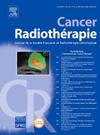Hypofractionated radiotherapy for head and neck squamous cell carcinoma
IF 1.4
4区 医学
Q4 ONCOLOGY
引用次数: 0
Abstract
Head and neck squamous cell carcinoma management involves surgery, radiotherapy, and systemic therapies. While normofractionated radiotherapy with concurrent chemotherapy remains standard, alternative fractionation schedules, such as hypofractionation, hold the potential to shorten treatment duration and therefore limit tumour repopulation, as well as improve patient adherence. Studies have explored hypofractionated radiotherapy in both exclusive and postoperative settings for head and neck squamous cell carcinoma. Recent studies like HYPNO randomized phase III trial (delivering 55 Gy in 20 fractions) and HYPORT phase I study (delivering 46.5 Gy in 15 fractions) have shown the feasibility and non-inferiority of hypofractionated radiotherapy compared to standard schedules but these results are insufficient to consider hypofractionated radiotherapy in exclusive and postoperative settings. Hypofractionated radiotherapy has been tested in several clinical situations: for early glottic cancer, in elderly patients, for metastatic disease/in palliative context. For early glottic cancers (T1–T2), moderate hypofractionation is a well-established strategy that showed its non-inferiority in terms of disease control and acceptable toxicity, notably in the JCOG0701 trial (delivery of 60 to 64.8 Gy in 25 to 27 fractions). Stereotactic body radiotherapy for glottic carcinoma has shown encouraging preliminary results in phase I-II studies, particularly when patient selection criteria are applied but caution remains necessary. In elderly patients, split-course hypofractionated radiotherapy reduced fraction number with favourable tolerance profile. The results of the ELAN-RT randomized phase III study support the possibility to prescribe a hypofractionated radiotherapy in elderly people. In palliative settings, hypofractionated radiotherapy regimens such as Christie and Hypo regimens have demonstrated effective symptom control. Overall, hypofractionated radiotherapy represents a promising strategy in selected clinical contexts for head and neck squamous cell carcinoma, but further prospective randomized studies are needed to define optimal indications and confirm long-term outcomes and safety.
低分割放疗治疗头颈部鳞状细胞癌
头颈部鳞状细胞癌的治疗包括手术、放疗和全身治疗。虽然同步化疗的正分割放疗仍然是标准,但其他分割方案,如低分割,有可能缩短治疗时间,从而限制肿瘤复发,并提高患者的依从性。研究已经探索了低分割放疗在头颈部鳞状细胞癌的排他和术后设置。最近的研究,如HYPNO随机III期试验(20次提供55 Gy)和HYPORT I期研究(15次提供46.5 Gy),与标准计划相比,显示了低分割放疗的可行性和非劣效性,但这些结果不足以考虑在排他和术后环境下的低分割放疗。低分割放疗已在几种临床情况下进行了试验:早期声门癌、老年患者、转移性疾病/姑息治疗。对于早期声门癌(T1-T2),适度低分割是一种行之有效的策略,在疾病控制和可接受的毒性方面显示出其非劣效性,特别是在JCOG0701试验中(按25至27份递送60至64.8 Gy)。立体定向放射治疗声门癌在I-II期研究中显示出令人鼓舞的初步结果,特别是在应用患者选择标准时,但仍需谨慎。在老年患者中,分程低分割放疗减少了分数,并具有良好的耐受性。ELAN-RT随机III期研究的结果支持在老年人中开低分割放疗处方的可能性。在姑息治疗中,低分割放疗方案如Christie和Hypo方案已被证明有效地控制症状。总体而言,在头颈部鳞状细胞癌的特定临床情况下,低分割放疗是一种很有前景的策略,但需要进一步的前瞻性随机研究来确定最佳适应症,并确认长期结果和安全性。
本文章由计算机程序翻译,如有差异,请以英文原文为准。
求助全文
约1分钟内获得全文
求助全文
来源期刊

Cancer Radiotherapie
医学-核医学
CiteScore
2.20
自引率
23.10%
发文量
129
审稿时长
63 days
期刊介绍:
Cancer/radiothérapie se veut d''abord et avant tout un organe francophone de publication des travaux de recherche en radiothérapie. La revue a pour objectif de diffuser les informations majeures sur les travaux de recherche en cancérologie et tout ce qui touche de près ou de loin au traitement du cancer par les radiations : technologie, radiophysique, radiobiologie et radiothérapie clinique.
 求助内容:
求助内容: 应助结果提醒方式:
应助结果提醒方式:


